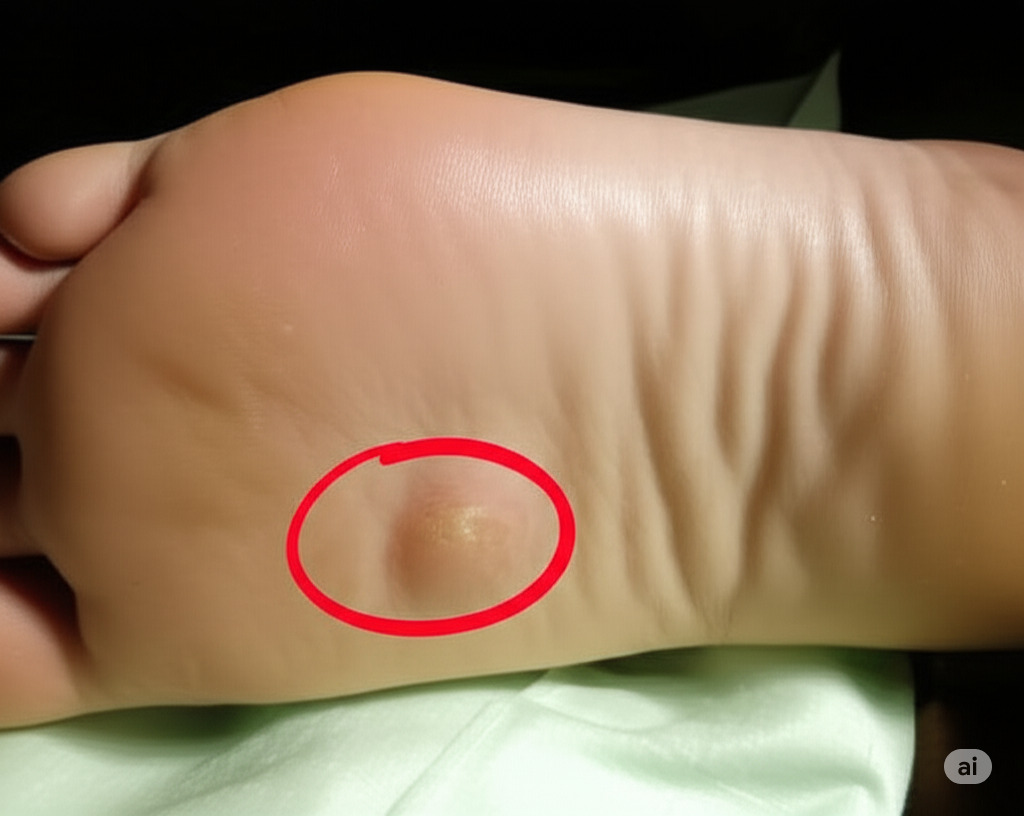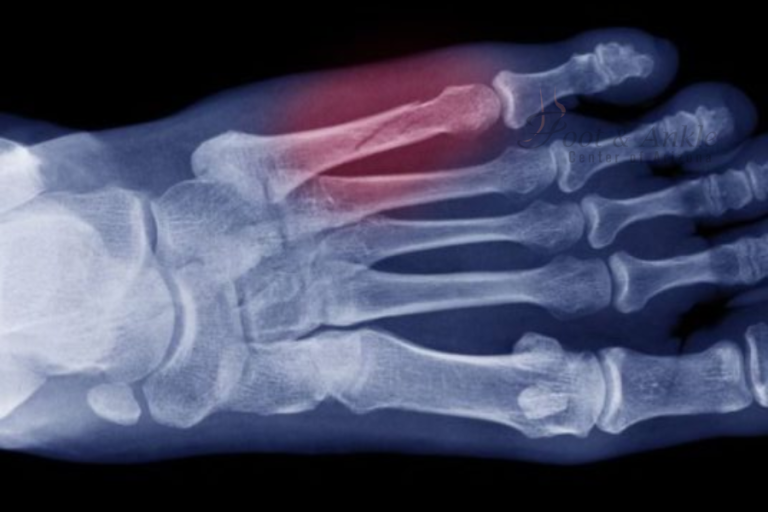Summary:
Plantar Fibroma Massage is a non-invasive, natural approach to relieving pain and discomfort caused by a plantar fibroma—a firm lump in the arch of the foot. This targeted massage technique helps improve blood circulation, reduce tension in surrounding tissues, and manage symptoms without surgery. When performed regularly, either professionally or at home, Plantar Fibroma Massage can significantly enhance foot mobility and comfort. While it won’t eliminate the fibroma, it’s a valuable tool for long-term relief. For the best results, massage therapy should be combined with proper footwear, stretching, and expert care from a foot specialist like Dr. Kris A. DiNucci.
A plantar fibroma is a noncancerous growth that forms in the arch of the foot within the plantar fascia, the band of tissue that connects the heel to the toes. While generally benign, this condition can lead to significant discomfort, especially when walking or standing for long periods. Understanding how plantar fibroma massage can help manage symptoms is essential for those looking for non-surgical relief.
What Causes Plantar Fibroma?
Although the exact cause of plantar fibromas remains unknown, contributing factors may include:
- Genetics
- Repeated trauma to the foot
- Certain medical conditions like diabetes or epilepsy
- Use of specific medications such as beta-blockers
Recognizing the underlying cause can be a vital step toward finding the right treatment strategy, including therapeutic massage.
Common Symptoms of Plantar Fibroma
Some individuals may not even realize they have a plantar fibroma until it becomes painful. Common signs include:
- A noticeable lump in the arch of the foot
- Pain when walking or standing
- Tightness or tension in the plantar fascia
- Difficulty wearing certain shoes
When these symptoms begin to interfere with daily life, many seek alternatives to invasive procedures — and that’s where plantar fibroma massage enters the conversation.
Can Massage Help with Plantar Fibroma?
Yes, in many cases, plantar fibroma massage can help alleviate discomfort by loosening the surrounding fascia, improving blood flow, and reducing inflammation. While massage won’t eliminate the fibroma entirely, it may reduce the size of the lump and relieve the pain associated with it.
Massage therapy can also:
- Improve flexibility in the arch
- Break down adhesions and scar tissue
- Prevent further progression of the fibroma
- Complement other conservative treatments like orthotics or stretching
Types of Massage Techniques for Plantar Fibroma
There are several massage techniques that can be beneficial for individuals suffering from plantar fibroma. These include:
1. Deep Tissue Massage
This involves applying firm pressure to the plantar fascia to help break up thickened tissue. It may be uncomfortable at first but is often effective for long-term relief.
2. Myofascial Release
This gentle, sustained pressure targets the fascia around the fibroma. It helps release tightness and promotes elasticity in the foot’s connective tissues.
3. Cross-Fiber Friction Massage
By moving across the fibrous tissue in the foot, this technique helps break down scar tissue and encourages the tissue to realign.
4. Trigger Point Therapy
Targeting specific pressure points around the plantar area, this technique can relieve tension and referred pain often caused by fibromas.
Self-Massage Techniques You Can Try at Home
If you’re not able to visit a professional therapist right away, self-massage can be a valuable part of your daily routine. Here are a few easy steps:
- Warm-up: Soak your feet in warm water for 10 minutes to loosen the fascia.
- Use your thumbs: Apply gentle pressure to the fibroma and massage in circular motions for 5–10 minutes.
- Massage tools: Try using a massage ball or frozen water bottle to roll under your foot — this can help with inflammation and tightness.
- Consistency matters: Perform self-massage daily, especially in the morning or after long periods of standing.
Combining Massage with Other Non-Surgical Treatments
While massage is a valuable part of conservative treatment, it’s most effective when combined with other therapies, such as:
- Custom orthotics: These reduce pressure on the fibroma when walking.
- Stretching exercises: Regular calf and plantar fascia stretches improve mobility.
- Topical anti-inflammatory creams: Used post-massage to calm irritated tissue.
- Night splints: These keep the foot stretched while you sleep to prevent tightening.
When to See a Specialist
If you’ve been massaging your foot regularly without seeing any relief or if the lump continues to grow, it may be time to consult a foot and ankle specialist. Professional evaluation can help determine if further intervention, such as corticosteroid injections or surgical removal, is needed.
At the Foot and Ankle Center of Arizona, our expert team, led by Dr. Kris A. DiNucci, DPM, FACFAS, provides personalized care plans that may include massage therapy as part of a holistic, non-surgical approach.
Precautions to Keep in Mind
Although plantar fibroma massage is generally safe, there are a few important precautions:
- Avoid massaging directly on inflamed or swollen tissue.
- Do not use excessive force, which can worsen the condition.
- People with diabetes or nerve issues should consult a podiatrist before attempting self-massage.
The Role of Professional Massage Therapists
While self-massage is helpful, working with a licensed massage therapist who understands plantar conditions can offer deeper relief and a more targeted approach. Many therapists collaborate with podiatrists to deliver custom treatment protocols based on the individual’s needs.
Most Common FAQs
What is the best massage for plantar fibroma?
Massage for plantar fibroma focuses on loosening the fascia around the lump, improving blood flow, and reducing pain. Techniques like deep tissue massage, myofascial release, and cross-fiber friction can be effective for long-term relief.
Can a muscle knot in arch of foot massage help with plantar fibroma?
Yes, a muscle knot in arch of foot massage can target tight fascia and surrounding tissue, reducing discomfort associated with plantar fibroma. Combining self-massage with professional therapy often yields the best results.
How does plantar fibroma massage relieve pain?
Plantar fibroma massage helps reduce tension in the arch, break down adhesions, improve circulation, and prevent stiffness. While it won’t completely remove the fibroma, it can significantly alleviate discomfort and improve mobility.
What are the most effective plantar fibroma treatment options besides massage?
Plantar fibroma treatment may include stretching exercises, custom orthotics, topical anti-inflammatory creams, night splints, and in some cases, corticosteroid injections or surgery. Massage is a valuable part of a comprehensive non-surgical approach.
What causes plantar fibroma?
What Causes Plantar Fibroma? The exact cause is unknown, but factors may include genetics, repeated foot trauma, certain medical conditions like diabetes or epilepsy, and the use of some medications. Identifying the cause helps in planning effective treatment strategies, including plantar fibroma massage.
Conclusion: Massage as a Key Player in Managing Plantar Fibroma
Plantar fibroma doesn’t always require surgery. With proper care, including plantar fibroma massage, many patients find lasting relief from pain and improved foot function. Whether you’re just starting to experience symptoms or seeking alternatives to surgery, massage therapy is a promising option worth exploring.
If you are in the Phoenix or Scottsdale area and battling plantar fibroma, the trained professionals at the Foot and Ankle Center of Arizona are ready to help. We provide full-service, patient-centered care — from the conservative modalities of massage to complex surgical interventions when needed.




